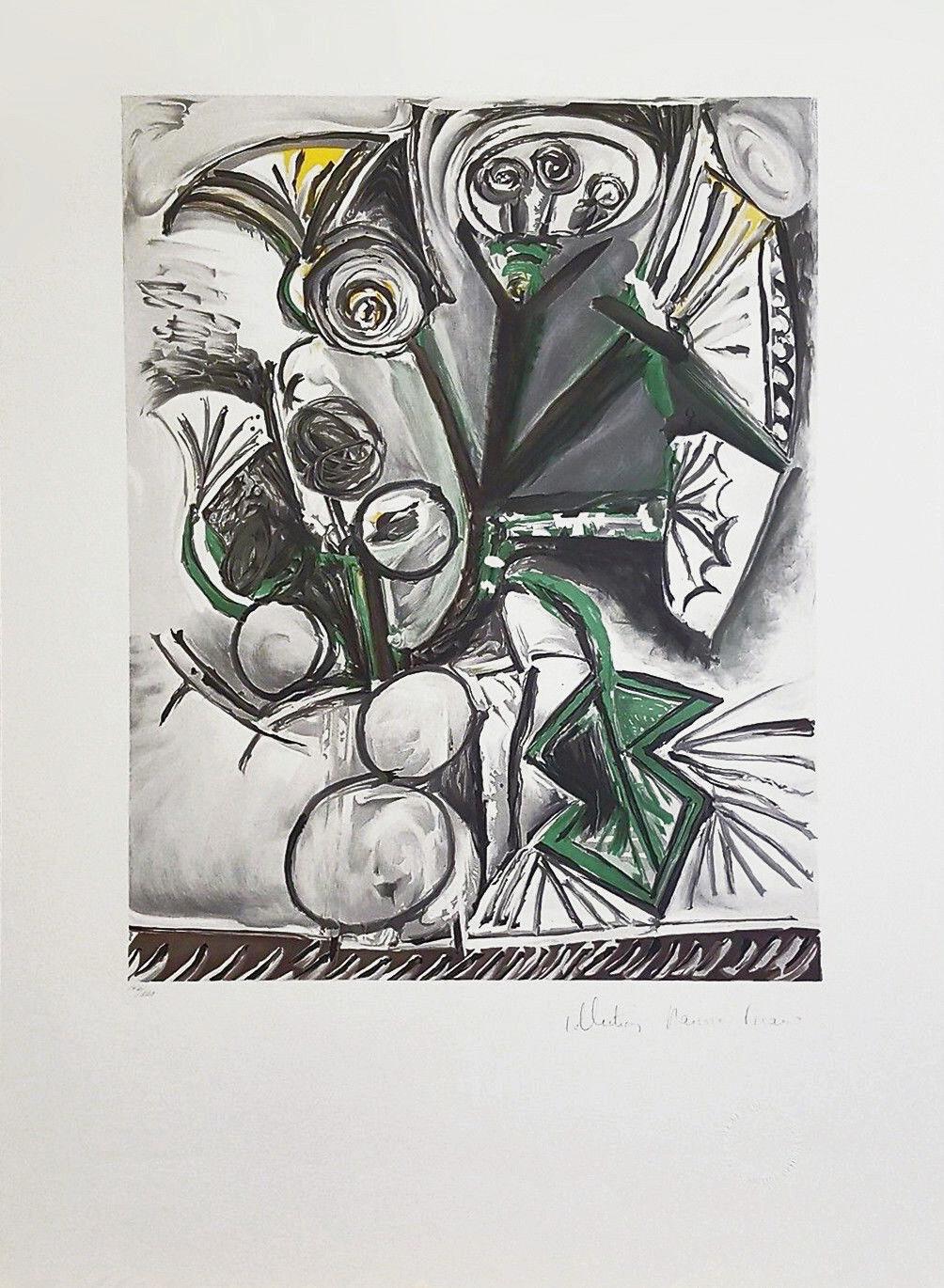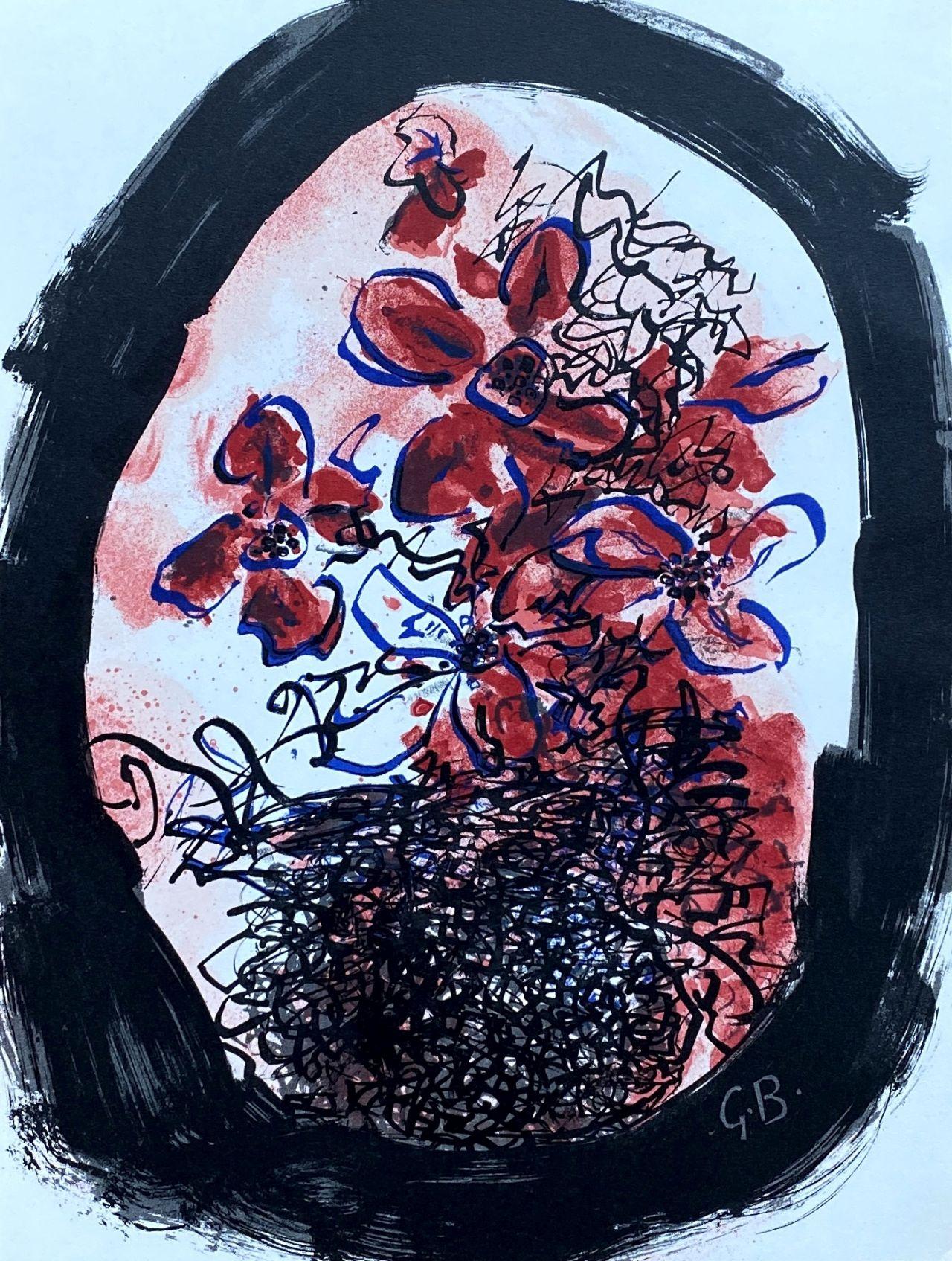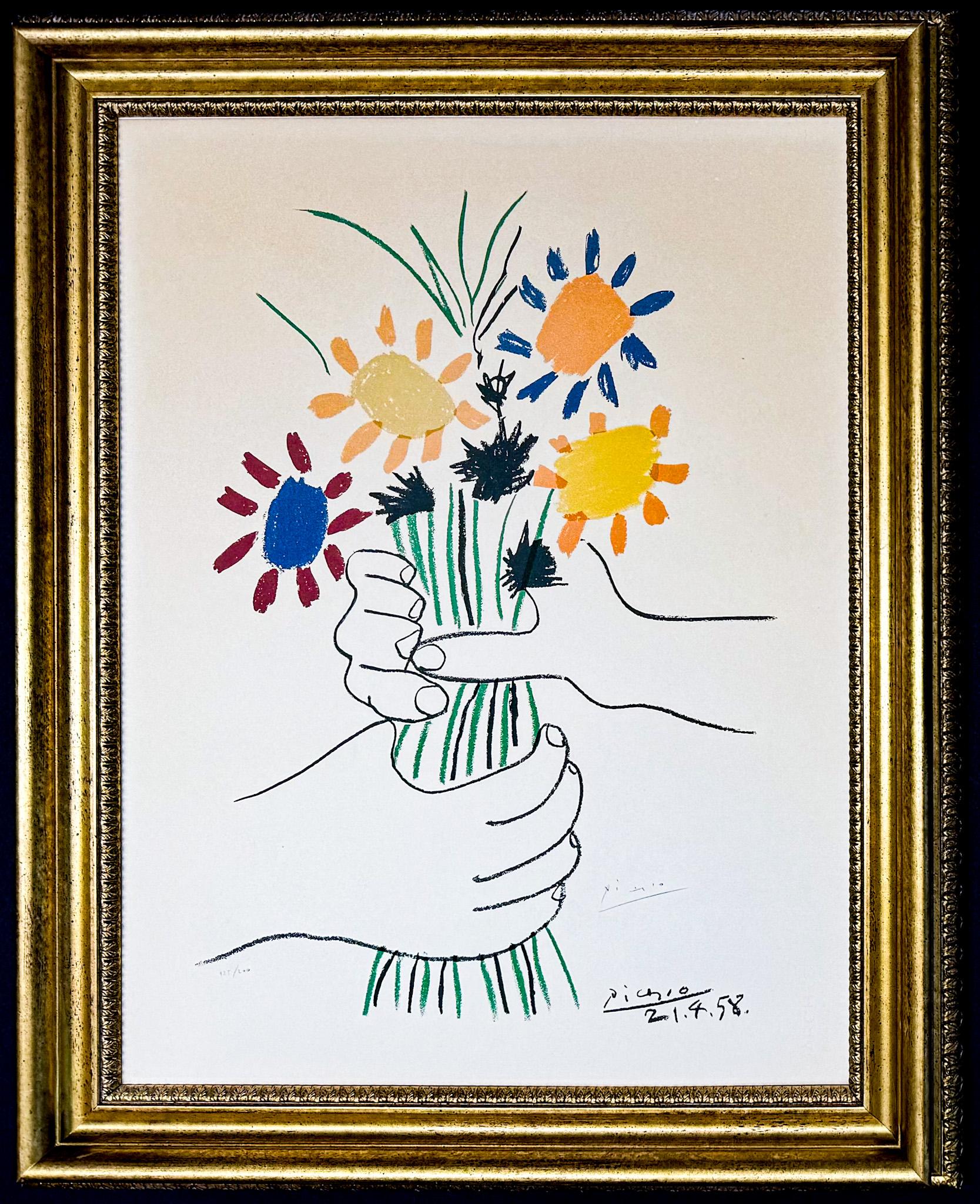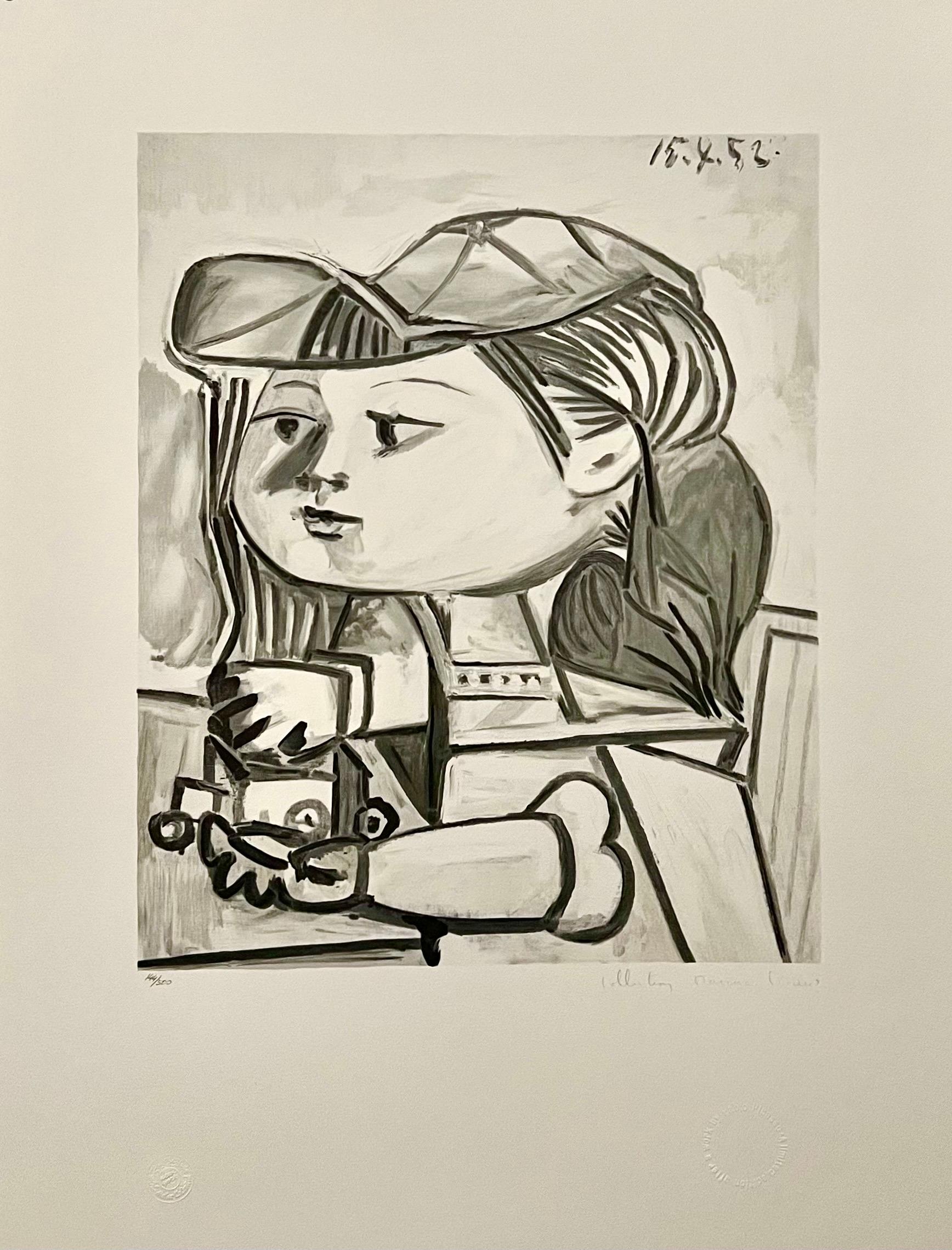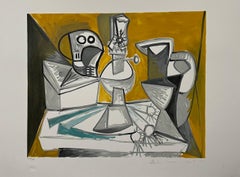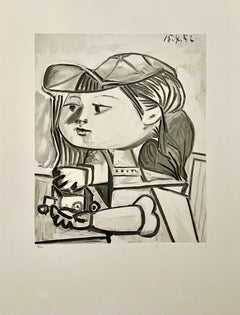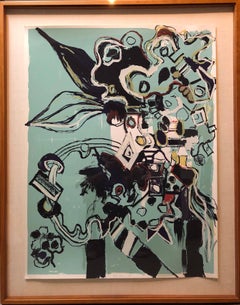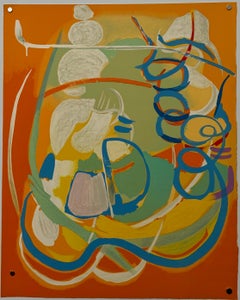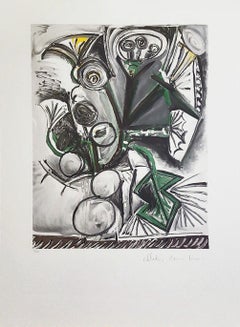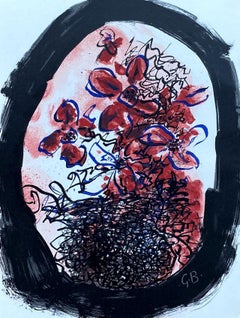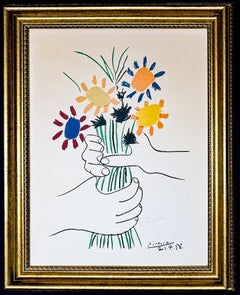Items Similar to Pablo Picasso Estate Hand Signed Cubist Lithograph Abstract Flowers Bouquet
Want more images or videos?
Request additional images or videos from the seller
1 of 15
Pablo Picasso Estate Hand Signed Cubist Lithograph Abstract Flowers Bouquet1982
1982
$4,000
£3,054.32
€3,477.46
CA$5,616.63
A$6,140.08
CHF 3,248.38
MX$73,475.90
NOK 41,330.94
SEK 37,834.29
DKK 25,974.46
About the Item
Pablo Picasso (after)
"Le Bouquet" Bouquet of flowers, abstract floral arrangement.
limited edition print on Arches paper,
Hand signed by Marina Picasso lower right and numbered 244/500 lower left
From the estate of Pablo Picasso with an embossed blindstamp in the lower right side of the piece.
After Pablo Picasso's death in 1973, his granddaughter Marina authorized the printing of these original lithographs, which have come to be known as the Picasso Estate Collection. The lithographs were meticulously created after the original works (Oil Paintings, Watercolors, Pastels, Charcoal Drawings, etc.) by Master Chromist Marcel Salinas, who worked closely with Picasso in his lifetime. They are printed in an edition of 500 on Arches paper. Embossed with the estate and chromist's stamp seals, along with the legend on the reverse "Approved by the heirs of Pablo Picasso".
Image: 18" x 15". Paper: 29 1/2" x 22".
Pablo Ruiz Picasso (1881 – 1973) was a Spanish painter, sculptor, printmaker, ceramicist, stage designer, poet and playwright who spent most of his adult life in France. Regarded as one of the most influential artists of the 20th century, he is known for co-founding the Cubist movement, the invention of constructed sculpture, the co-invention of collage, and for the wide variety of styles that he helped develop and explore. Among his most famous works are the proto-Cubist Les Demoiselles d'Avignon (1907), and Guernica (1937), a dramatic portrayal of the bombing of Guernica by the German and Italian air forces during the Spanish Civil War.
Picasso demonstrated extraordinary artistic talent in his early years, painting in a naturalistic manner through his childhood and adolescence. During the first decade of the 20th century, his style changed as he experimented with different theories, techniques, and ideas. After 1906, the Fauvist work of the slightly older artist Henri Matisse motivated Picasso to explore more radical styles, beginning a fruitful rivalry between the two artists, who subsequently were often paired by critics as the leaders of modern art.
Picasso's work is often categorized into periods. While the names of many of his later periods are debated, the most commonly accepted periods in his work are the Blue Period (1901–1904), the Rose Period (1904–1906), the African-influenced Period (1907–1909), Analytic Cubism (1909–1912), and Synthetic Cubism (1912–1919), also referred to as the Crystal period. Much of Picasso's work of the late 1910s and early 1920s is in a neoclassical style, and his work in the mid-1920s often has characteristics of Surrealism. His later work often combines elements of his earlier styles.
In 1907, Picasso joined an art gallery that had recently been opened in Paris by Daniel-Henry Kahnweiler. Kahnweiler was a German art historian and art collector who became one of the premier French art dealers of the 20th century. He was among the first champions of Pablo Picasso, Georges Braque and the Cubism that they jointly developed. Kahnweiler promoted burgeoning artists such as André Derain, Kees van Dongen, Fernand Léger, Juan Gris, Maurice de Vlaminck and several others who had come from all over the globe to live and work in Montparnasse at the time.Picasso participated in the School Prints, to bring art to the masses in the 1940's. A magnificent European series, made possible by plastic portable plates, which, in addition to Henry Moore, featured Henri Matisse, Pablo Picasso, Fernand Leger, Raoul Dufy and Georges Braque.
- Creation Year:1982
- Dimensions:Height: 29.5 in (74.93 cm)Width: 22 in (55.88 cm)
- Medium:
- Movement & Style:
- After:Pablo Picasso (1881-1973, Spanish)
- Period:
- Condition:good. never framed. very minor wear. please see photos.
- Gallery Location:Surfside, FL
- Reference Number:1stDibs: LU38212684182
About the Seller
4.9
Platinum Seller
Premium sellers with a 4.7+ rating and 24-hour response times
Established in 1995
1stDibs seller since 2014
1,845 sales on 1stDibs
Typical response time: 1 hour
- ShippingRetrieving quote...Shipping from: Surfside, FL
- Return Policy
More From This Seller
View AllPablo Picasso Estate Hand Signed Lithograph Abstract Cubist Composition
By Pablo Picasso
Located in Surfside, FL
Pablo Picasso (after)
"Tete De Mort, Lampe, Cruches Et Poireaux"
limited edition print on Arches paper,
Hand signed by Marina Picasso lower right and numbered 318/500 lower left
Fr...
Category
20th Century Modern Abstract Prints
Materials
Lithograph
Pablo Picasso Estate Hand Signed Cubist Lithograph Abstract Girl Portrait Tete
By Pablo Picasso
Located in Surfside, FL
Pablo Picasso (after)
"Buste de Petite Fille"
limited edition print on Arches paper,
Hand signed by Marina Picasso lower right and numbered 144/500 lower left
From the estate of Pa...
Category
20th Century Modern Abstract Prints
Materials
Lithograph
Large Format Modernist Abstract Lithograph Silkscreen Print Woman Artist
By Lydia Dona
Located in Surfside, FL
1982-84 Hunter College, New York (M.F.A.)
1978-80 School of Visual Arts, New York
1973-77 Bezalel Academy of Art, Jerusalem (B.F.A.)
American, born in Romania
Lives and works in New York City
Solo Exhibitions
2008 Michael Steinberg Fine Art, New York
2006 Galeria Joan Prats, Barcelona
2005 Karpio + Facchini Gallery, Miami
Jacob Karpio Galeria, San Jose (Costa Rica)
2004 Michael Steinberg Fine Art, New York
2001 Marella Arte Contemporanea, Milan
2000 Von Lintel & Nusser, New York
Galerie Von Lintel & Nusser, Munich
1998 Galerie Thomas von Lintel, Munich
1997 Galerie des Archives, Paris
1995 Galerie Samuel Lallouz, Montreal
L.A. Louver, Los Angeles
1994 Marc Jancou Gallery, London
Galerie des Archives, Paris
1993 Galerie Barbara Farber, Amsterdam
Real Art Ways, Hartford (Connecticut)
1992 Tom Cugliani Gallery, New York
Galerie Marc Jancou, Zurich
Galerie des Archives, Paris
1989 Tom Cugliani Gallery, New York
Galerie Barbara Farber, Amsterdam
Studied at bezalel from 1973 to 1977. And it was a very fascinating time because it was a highly conceptually based school. Very much influenced by Joseph Beuys, and European Conceptualism, I didn’t really like the atmosphere there that much, because it was dominated by male painters like Jörg Immendorf, Marcus Lupertz, and a few others. then came to New York to study at SVA for two years. New York in 1978 was exciting. I was very lucky to be in a class that was full of very bubbly and very energetic artists like Keith Haring, Kenny Scharf, Tim Rollins, Moira Dryer, Frank Holliday, and Tom Cugliani (who later became one of my dealers).The eighties were dominated largely by Neo-Expressionist paintings. There were Germans, such as Baselitz, Kiefer, Richter, Penck, and the Italians, Clemente, Chia, Cucchi, Palladino as well as Schnabel, Fischl, Basquiat, Salle, and many others, but all of their paintings were figuratively based. But below the popular consent, there was a group of painters who were working more in the vein of what Stephen Westfall referred to as “Neo-Surrealism,” including George Condo, Jeffrey Wasserman, Kenneth Scharf, David Humphrey. However, I felt that Carroll Dunham and you were the only two painters who seemed to be less interested in the kind of narrative, lyrical, or let’s say, stationary composition. He belongs to the generation of Terry Winters, Elizabeth Murray, David Reed and Jonathan Lasker but in some strange way, if we’re looking back to the mid-eighties, we have to include New Image painters like Susan Rothenberg, Neil Jenney, and Robert Moskowitz who were working in between the figure and abstraction with a kind of condensation and compression, in relationship, lets say, to cartoon imagery. There are artists like Jeff Koons, or even Damien Hirst who took the Duchampian aspect and brought it into the continuity of his readymade. But for me, I see no difference between the crack in “Large Glass” and the drips in Jackson Pollock’s paintings. There was something that I felt in my own equation of the continuity between Paul Klee, Duchamp, Picabia, and, oddly enough, Clyfford Still.
What essentially is important is how different artists carry on a dialogue among themselves so that they can all keep their work vital. Whether from the abstract paintings of Richmond Burton, Fabian Marcaccio extending the borders of his paintings on to the wall, or Cady Noland’s early scattered installation, my own pre-occupation with machinery, urban environment, and the Duchampian models has always materialized in relationship to other forms of art making.
Selected Group Exhibitions:
2014 Drawing on Difference: An Ambition by Saul Ostrow and Lidija
Slavkovic, Studio Vendome Gallery, New York.
2013 Drawing on Habit: An Ambition by Saul Ostrow and Lidija Slavkovic,
South Carlton Beach and The Betsy-South Beach Exhibition Programs,
Art Basel, Miami Beach.
2013 Imprinted Pictures: Lydia Dona...
Category
1980s Abstract Expressionist Abstract Prints
Materials
Lithograph, Screen
Andre Lanskoy Dada Lithograph Mourlot Calligraphic French Poetry Brut Abstract
By André Lanskoy
Located in Surfside, FL
ANDRE LANSKOY (French / Russian 1902-1976)
1966
Original color lithograph on watermarked Arches paper
The title sheet was hand signed in pencil on the justification page by the arti...
Category
1970s Surrealist Abstract Prints
Materials
Lithograph
Pietro Consagra Italian Mod Abstract Expressionist Forma Art Informel Lithograph
By Pietro Consagra
Located in Surfside, FL
Pietro Consagra (Italian, 1920-2005).
Hand signed in pencil and numbered limited edition color lithograph on Magnani paper.
Embossed stamp with limited edition numbers in pencil to lower left, and having artist pencil signature to lower right.
(from a limited edition of 80 with 15 artist's proofs)
Published by Stamperia 2RC, Rome Italy and Marlborough Gallery, Rome, Italy.
Abstract Modernist work in colors, produced in the style of the Forma art movement of Postwar Italy, of which the artist was a prominent member.
Pietro Consagra (1920 – 2005) was an Italian Post war artist working in painting, printmaking and sculpture. In 1947 he was among the founding members of the Forma 1 group of artists, proponents of structured abstraction. (similar to the Art Informel and Art Brut in France and the Brutalist artists)
Consagra was born on 6 October 1920 in Mazara del Vallo, in the province of Trapani in south-western Sicily, to Luigi Consagra and Maria Lentini. From 1931 he enrolled in a trade school for sailors, studying first to become a mechanic, and later to become a captain. In 1938 he moved to Palermo, where he enrolled in the liceo artistico; despite an attack of tuberculosis, he graduated in 1941, and in the same year signed up at the Accademia di Belle Arti, where he studied sculpture under Archimede Campini. After the Invasion of Sicily and the Allied occupation of Palermo in 1943, Consagra found work as a caricaturist for the American Red Cross club of the city; he also joined the Italian Communist Party. Early in 1944, armed with a letter of introduction from an American officer, he travelled to Rome. There he came into contact with the Sicilian artist Concetto Maugeri, and through him with Renato Guttuso, who was also Sicilian and who introduced him to the intellectual life of the city and to other postwar artists such as Leoncillo Leonardi, Mario Mafai and Giulio Turcato. Consagra signed up at the Accademia di Belle Arti di Roma in September 1944 and studied sculpture there under Michele Guerrisi, but left before completing his diploma.
In 1947, with Carla Accardi, Ugo Attardi, Piero Dorazio, Mino Guerrini, Achille Perilli, Antonio Sanfilippo and Giulio Turcato, Consagra started the artist's group Forma 1, which advocated both Marxism and structured abstraction.
Steadily Consagra's work began to find an audience. Working primarily in metal, and later in marble and wood, his thin, roughly carved reliefs, began to be collected by Peggy Guggenheim and other important patrons of the arts. He showed at the Venice Biennale eleven times between 1950 and 1993, and in 1960 won the sculpture prize at the exhibition. During the 1960s he was associated with the Continuità group, an offshoot of Forma I, and in 1967 taught at the School of Arts in Minneapolis. Large commissions allowed him to begin working on a more monumental scale, and works of his were installed in the courtyard of the Foreign Ministry in Rome and in the European Parliament, Strasbourg. His work is found in the collections of The Tate Gallery, London, in Museo Cantonale d'Arte of Lugano and the Museum of Modern Art, Paris, and the National Gallery of Art in Washington, D.C..
Consagra returned to Sicily where he sculpted a number of significant works during the 1980s. With Senator Ludovico Corrao, he helped created an open-air museum in the new town of Gibellina, after the older town had been destroyed in the earthquake of 1968. Consagra designed the gates to the town's entrance, the building named "Meeting" and the gates to the cemetery, where he was later buried.
In 1952 Consagra published La necessità della scultura ("the need for sculpture"), a response to the essay La scultura lingua morta ("sculpture, a dead language"), published in 1945 by Arturo Martini. Other works include L'agguato c'è ("the snare exists", 1960), and La città frontale ("the frontal city", 1969). His autobiography, Vita Mia, was published by Feltrinelli in 1980. In 1989 a substantial retrospective exhibition of work by Consagra was shown at the Galleria Nazionale d'Arte Moderna in Rome; in 1993 a permanent exhibition of his work was installed there. In 1991 his work was shown in the Hermitage Museum in St. Petersburg. In 2002 the Galerie der Stadt Stuttgart opened a permanent exhibition of his work. He was one of ten artists invited by Giovanni Carandente, along with David Smith, Alexander Calder, Arnaldo Pomodoro, Lynn Chadwick, and Beverly Pepper, to fabricate works in Italsider factories in Italy for an outdoor exhibition, "Sculture nella città", held in Spoleto during the summer of 1962. He was included in the The 1962 International Prize for Sculpture the jury included Argan, Romero Brest and James Johnson Sweeney the former director of the Solomon R. Guggenheim Museum in New York. The participants included Louise Nevelson and John Chamberlain for the United States; Lygia Clark for Brazil; Pietro Consagra, Lucio Fontana, Nino Franchina, and Gió Pomodoro for Italy; Pablo Serrano for Spain; and Eduardo Paolozzi, William Turnbull, and Kenneth Armitage for England. Gyula Kosice, Noemí Gerstein...
Category
1960s Abstract Expressionist Abstract Prints
Materials
Lithograph
Pablo Picasso Estate Hand Signed Fauvist Lithograph Woman Portrait Marie Therese
By Pablo Picasso
Located in Surfside, FL
Pablo Picasso (after)
"Portrait de Marie Therese"
limited edition print on Arches paper,
Hand signed by Marina Picasso lower right and numbered 274/500 lower left
From the estate of...
Category
20th Century Modern Abstract Prints
Materials
Lithograph
You May Also Like
Vase de Fleurs, Cubist Lithograph after Pablo Picasso
By Pablo Picasso
Located in Long Island City, NY
A lithograph from the Marina Picasso Estate Collection after the Pablo Picasso painting "Vase de Fleurs". The original painting was completed in 1958. In the 1970's after Picasso's ...
Category
1980s Modern Still-life Prints
Materials
Lithograph
Le Bouquet (from Picasso Estate Collection)
By (after) Pablo Picasso
Located in Aventura, FL
Selected from the personal collection inherited by Marina Picasso, Pablo Picasso's granddaughter. After Pablo Picasso's death, his granddaughter Marina authorized the printing of t...
Category
1980s Cubist Still-life Prints
Materials
Paper, Lithograph
$1,475 Sale Price
50% Off
Bouquet of Flowers - Original Lithograph - Signed in the Plate (Vallier #188)
By Georges Braque
Located in Paris, IDF
Georges BRAQUE
Bouquet of flowers, 1961
Original lithograph in six colors (Mourlot workshop)
Printed signature in the plate
On vellum 34 x 26 cm (c. 13 x 10 inch)
REFERENCE : Catal...
Category
1960s Expressionist Still-life Prints
Materials
Lithograph
Pablo Picasso (1881 - 1973) - Bouquet de Fleurs-Color lithograph on Arches paper
By Pablo Picasso
Located in Varese, IT
Color lithograph on Arches paper, edited in 1958
Limited edition of 200 copies
Current copy numbered: 125/200 on the lower left corner
Signed in pencil by artist in lower right corne...
Category
1950s Abstract Prints and Multiples
Materials
Lithograph
Flowers - Original Lithograph by Ernesto Treccani - 1973
By Ernesto Treccani
Located in Roma, IT
Flowers is an Original Lithograph realized by Ernesto Treccani in 1973.
Limited edition of 125 copies, editor "La Nuova Foglio SPA".
Very good condition on a white cardboard.
Hand...
Category
1970s Modern Figurative Prints
Materials
Lithograph
Flowers - Lithograph by Ernesto Treccani - 1973
By Ernesto Treccani
Located in Roma, IT
Flowers is an Original Lithograph realized by Ernesto Treccani in 1973.
Limited edition of 125 copies, editor "La Nuova Foglio SPA".
Very good condition on a white cardboard.
Hand...
Category
1970s Modern Abstract Prints
Materials
Lithograph
More Ways To Browse
Picasso Flower
Picasso Flower Print
Picasso Bouquet
Warhol Electric Chair
1966 Salvador Dali
Alexander Calder Signed Lithographs
Alexander Calder Sun
Andy Warhol 1984
Arthur Lismer
Bauhaus Lithograph
Calder Spirals
Claes Oldenburg Signed
Dali Lucas Gallery
Derriere Le Miroir 173
Fournier Paris
Gerard Martin
Helen Frankenthaler Lithographs
Helen Phillips

